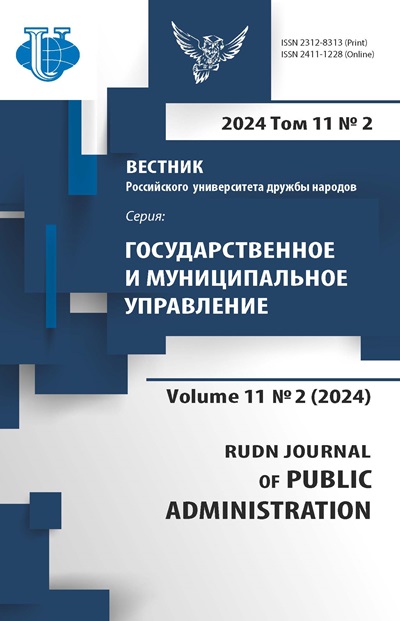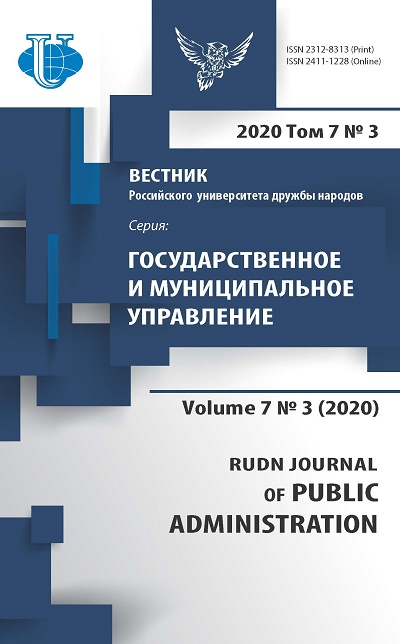Том 7, № 3 (2020)
- Год: 2020
- Статей: 8
- URL: https://journals.rudn.ru/public-administration/issue/view/1359
- DOI: https://doi.org/10.22363/2312-8313-2020-7-3
Весь выпуск
АКТУАЛЬНЫЕ ПРОБЛЕМЫ ГОСУДАРСТВЕННОГО УПРАВЛЕНИЯ
Африканская архитектура мира и безопасности как инструмент их поддержания. Часть 1
Аннотация
 179-194
179-194


Образ власти в контексте теории архетипов
Аннотация
Образы государственных деятелей часто отражают те общественные и социальные явления, которые происходят в обществе, поскольку становятся ценностным выбором большинства населения страны. В данной статье выдвигается гипотеза о том, что ценности представляют собой отражение архетипов коллективного бессознательного. В связи с этим исследование архетипов, с одной стороны, способствует созданию преемственности глубинных ценностных основ между прошлыми и будущим поколениями, с другой стороны, позволяет анализировать и прогнозировать успех или неудачу общественных и государственных инициатив. Также в периоды кризиса и распространения псевдоценностей можно говорить о проявлении в обществе архетипа Тени в образах лжегероев. В статье приводится пример рассмотрения архетипа Тени через анализ портретов российских политических деятелей 1990-х гг., представленного в концепции отечественного социолога Ж.Т. Тощенко.
 195-204
195-204


Влияние на национальную безопасность России интеграции зарубежных акторов в Центрально-Азиатский регион
Аннотация
После распада СССР перманентная внутриполитическая турбулентность породила политическую автократию и политическую борьбу с характерными для нее технологиями влияния на внутригосударственные процессы. При этом государства Центральной Азии начали активно включаться в глобальные мировые процессы. В то же время стала проявляться заинтересованность различных стран Востока и Запада в расширении своего экономического и геополитического присутствия в центрально-азиатском регионе. Одновременно происходила активизация идеологического воздействия на страны Центральной Азии. Различные внешние силы, преследуя конкретные цели, стремятся оказать свое влияние на внутренние процессы суверенных государств, зачастую вопреки интересам народов центрально-азиатского региона. В представленной статье автор анализирует влияние внешних акторов на внутренние процессы государств Центральной Азии с точки зрения обеспечения национальной безопасности России.
 205-225
205-225


МЕЖДУНАРОДНЫЙ ОПЫТ ГОСУДАРСТВЕННОГО УПРАВЛЕНИЯ
Крупный бизнес в высших эшелонах власти США. На примере Д. Трампа
Аннотация
В данной статье рассматривается один из ключевых компонентов механизма формирования правящих элит в США - экономический. Представители крупного бизнеса, финансовых кругов и политических кланов, способные бороться за власть и обладающие необходимой ресурсной базой и инструментарием, формируют элитарные группы. Авторы концентрируются на изучении крупного бизнеса США как поставщика «кадров» для американских политических элит, которые определяют внутреннюю и внешнюю политику США. В своей работе авторы ставят следующие задачи: проанализировать механизм формирования политических элит в США; рассмотреть опыт Trump Organization в контексте обретения ее руководителем высшего политического статуса в США в 2016 г. и перспектив его переизбрания на этот пост в 2020 г.; дать оценку роли крупного бизнеса в формировании политических элит США. Для достижения поставленных задач авторы использовали ряд методов политологической науки: структурный, системный, функциональный, сравнительный и исторический методы. Также была задействована и методология экономической науки: метод научной абстракции, метод нормативного и функционального анализа. Исследование в своей концептуальной основе опирается как на теорию политических элит, так и на экономическую теорию конкурентной борьбы.
 226-238
226-238


Влияние кадрового потенциала, бюджетного планирования, политического бюджетирования и прозрачности для общественности на документы APBD и синхронизацию KUA-PPAS в правительстве района Муси Банюасин, Индонезия
Аннотация
Цель данного исследования - определить влияние кадрового потенциала, бюджетного планирования, политического бюджетирования и общественной прозрачности на синхронизацию между документом о бюджете региональных доходов и расходов, общей политикой бюджета региональных доходов и расходов и утвержденным бюджетом. Исследование проводится на основе анализа района Муси Банюасин в Индонезии. В исследовании приняли участие советники и должностные лица / сотрудники, участвующие в подготовке плана работы над бюджетом, в который было включено 33 региональных подразделения. Выборка включала в себя 127 представителей региональных подразделений. В исследовании используют первичные данные, полученные данные были проанализированы через множество циклов линейной регрессии. Гипотезы одновременно и частично проверяются F-тестом и t-тестом. Результаты проведенного исследования показали, что параллельное использование потенциала человеческих ресурсов, бюджетного планирования, политического бюджетирования и прозрачности для общественности оказывает положительное и существенное влияние на синхронизацию бюджетных документов, бюджетной политики и утвержденного бюджета. Результаты и концептуальный вклад данного исследования могут быть полезны в сфере государственного управления в Индонезии и других странах, особенно в деятельности правительства и парламента, так как они должны быть более последовательными и иметь высокую приверженность в отношении бюджетирования.
 239-253
239-253


Провал руководства и проблема безработицы среди молодежи в Нигерии
Аннотация
История Нигерии омрачена недостатками моральных и этических ценностей в поведении правящих элит, что отрицательно сказалось на экономическом росте и развитии. Продолжающаяся нищета, усугубляемая острой безработицей среди молодежи, является препятствием на пути к укреплению демократии в Нигерии. Общество паразитирующих нищих и бандитов не может развиваться. Безработица среди молодежи была и остается основной социальной проблемой в Нигерии. Несмотря на политические протесты против безработицы, негативная в стране статистика все еще ошеломляет. Автор уверен, что корень этой проблемы кроется в политике недальновидных, эгоистичных, посредственных, трайбалистически и оппортунистски настроенных лидеров, которые формируют нигерийский политический ландшафт. Именно исходя из этого в исследовании рассматривается связь между провалами и неудачами руководства и острой безработицей среди молодежи в Нигерии. В основу исследования легли данные, собранные путем опроса трехсот респондентов в южной Нигерии с использованием метода выборки без вероятности. Собранные данные были проанализированы с использованием корреляционного и линейного регрессионного анализа с помощью статистического пакета для социальных наук (SPSS. Версия 21). Результаты исследования показали, что существует значительная связь между провалами руководства и острой безработицей среди молодежи. Как и предполагалось, исследование также показало, что недееспособность руководства оказывает негативное и статистически значимое влияние на уровень безработицы среди молодежи в Нигерии. На основании этих выводов авторами рекомендуется, чтобы правительство на всех уровнях предоставляло возможности безработным молодым людям заниматься индивидуальной трудовой деятельностью и трудоустройством путем реального расширения их прав и возможностей, пересмотреть схему развития сельского хозяйства с целью создания возможностей трудоустройства для безработных молодых людей, сегодня бесцельно бродящих по улицам Нигерии. Расширение прав и возможностей молодежи также невозможно без усиления борьбы против коррупции.
 254-271
254-271


Влияние инициированных ПРООН проектов на социально-экономическое развитие женщин: исследование сельских районов Пенджаба, Пакистан
Аннотация
Женщины составляют половину всего населения мира, при этом их положение по всему миру резко различается. Проблема расширение прав и возможностей женщин в XXI веке приобрела гораздо большую важность, чем прежде. Является доказанным фактом то, что без расширения возможностей половины населения страна не может достичь процветания в любой области. Целый ряд правительственных и неправительственных организаций интенсивно работают над вопросом расширения прав и возможностей женщин, не вызывает сомнений особый вклад Организации Объединенных Наций (ООН) в этой области, прежде всего заключающийся в том, что ее устав гарантирует основные права женщин. В течение последних двух десятилетий ООН было проведено много конференций, семинаров и практикумов по правам женщин в рамках глобального движения. Ряд учреждений ООН работают над этим вопросом, но наиболее эффективная работа по расширению прав и возможностей женщин была проведена Программой развития Организации Объединенных Наций (ПРООН). Она работает по всему миру путем пропагандирования, партнерства и предоставляет техническую поддержку и финансовую помощь правительственным и неправительственным организациям. В Пакистане женщины составляют 51,73% от общей численности населения. Положение женского населения, особенно в сельской местности, является в целом неблагоприятным. Часто женщины лишены своих основных прав, и уровень грамотности среди женщин также угрожающе низок. Будучи развивающимся государством, Пакистан зависит от финансовой помощи и технической поддержки со стороны международных агентств. После 18-й поправки к Конституции провинции страны получают всевозможную помощь непосредственно от учреждений-доноров. Сегодня из-за тяжелой ситуации в сельской местности страны «ПРООН Пакистан» работает в том числе над подъемом уровня жизни сельского населения. В этом статье подробно освещены социально-экономические последствия программы ПРООН для женщин.
 272-284
272-284


Связь между присутствием женщин в Парламенте и высшим образованием в Иране
Аннотация
В данной статье рассматривается положение женщин в политической жизни Ирана, рост уровня образования иранских женщин до и после Революции, связь между присутствием женщин в Парламенте и высшим образованием в Иране, а также успехи, достигнутые женщинами в иранских государственных организациях. Автор отмечает, что число иранских учащихся женского пола росло по мере увеличения возможностей университетов страны, наращивающих свой потенциал. Поэтому в данной статье поднимается следующий вопрос: повлияло ли повышение уровня образования иранских женщин на их участие в политической сфере страны?
 285-294
285-294
















